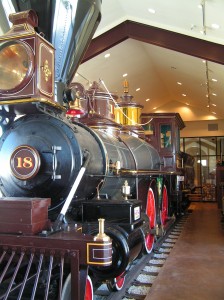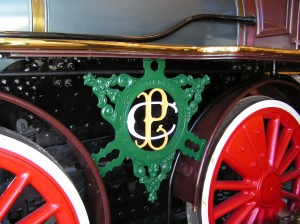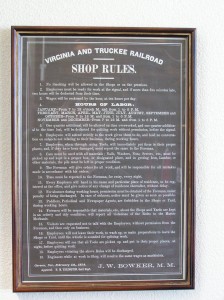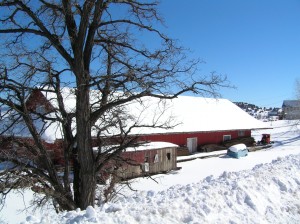I give you Joe V. Meigs’ elevated railway. It’s sort the way the Disneyland monorail might have appeared, if it had been built in 1886. And this wasn’t just a proposal; a prototype was apparently actually built.
Category Archives: Railroad
The Big Boy can do what???
The Union Pacific Class 4000 Big Boy is widely considered to be the most powerful class of steam locomotive ever built. Starting in 1941, 25 Big Boys were built for the Union Pacific Railroad by the American Locomotive Co. in Schenectady, New York. The Big Boys were articulated, meaning they could bend in the middle to go around curves, and had two sets of driving wheels, with eight drivers (four pairs) per set. Four smaller wheels made up the pilot truck in the front, to help ease the huge locomotive around curves. A trailing truck at the rear had another four wheels to carry the weight of the firebox. This gave the Big Boy a wheel arrangement of 4-8-8-4*.
The Big Boys were designed to pull heavy freight trains over the Wasatch Mountains. Prior to their delivery, long trains needed extra helper locomotives to get over the mountains. This meant delays while the helpers were put on and taken off, as well as paying for extra crews to operate them. Using Big Boys, each capable of pulling more than 4,400 tons up the 1.55% grade, resulted in significant savings of time and money.
Technology marches on, however, and even the most powerful steam locomotives in the world could not stay in service forever. The Big Boy’s last run came in 1959. The diesels that replaced them were individually far less powerful, but could be connected such that multiple units were all operated by a single crew. Today eight Big Boys still survive in museums, although none of them are in operating condition.
One thing about the Big Boy locomotives that I did not know until recently is that they can also operate in outer space, at least according to this anime. Yep, that’s right. Trains traveling through space, pulled by steam locomotives. Complete with steam whistle, and a big plume of smoke (The Big Boy first appears at around 2:10. If you freeze it at 2:18, the overhead view clearly shows coal in the tender.). And on top of everything else, this English language version of a Japanese cartoon also features space panzergrenadiers.
Every time I think that anime just can’t get any stranger…
* Steam locomotives are classified by wheel arrangement, read in order from front to rear.
Filed under Railroad, Space, Technology, Weirdness
HO scale V&T rant
I have been trying to model the Virginia & Truckee Railroad ca. 1873-78 in HO scale. This is the period of the Big Bonanza, when Virginia City was booming and the railroad ran as many as 40 trains a day over a steep, twisting, single track line with no signals. I say I’m trying to, because there’s one little problem: locomotives. Rio Grande Models makes kits of most of the freight cars I need, as well as a few of the passenger cars. The main thing they lack is ore cars, which are available from Comstock Carshops, along with several Virginia City buildings.
So why doesn’t anybody make HO scale V&T locomotives? There are a few old locos that occasionally show up on Ebay, but nothing that even remotely resembles state of the art. Can’t somebody make a high quality HO scale V&T locomotive, preferably equipped with DCC and sound? I’m not terribly picky; I’d happily take any locomotive that would have been seen in Virginia City before 1880. (If I’m remembering correctly, there were 19 of them.)
On a happier note, I picked up Mallory Hope Ferrell’s new book on the Nevada Central this afternoon. On first leaf-through, it looks like an excellent reference on a railroad that, until now, has not received nearly enough attention.
Now he just needs to produce a book about the Eureka & Palisade.
Filed under Railroad
Train porn
I took my camera down to Virginia City a couple of weeks ago. There was a lot of snow on the ground, which is not unusual for this time of year, but I was still able to get a few good pictures. (Click on any picture to embiggen.)
 This is Virginia & Truckee locomotive no. 18, the Dayton. She was built in the Central Pacific shops in Sacramento and delivered in 1873. From 1879 until 1938 Dayton was fitted with a snowplow. In 1939 Dayton appeared in the Cecil B. DeMille epic Union Pacific, and thirty years later she taken to Promontory Point, Utah for the Gold Spike Centennial. Her current home is at the Comstock History Center in Virginia City.
This is Virginia & Truckee locomotive no. 18, the Dayton. She was built in the Central Pacific shops in Sacramento and delivered in 1873. From 1879 until 1938 Dayton was fitted with a snowplow. In 1939 Dayton appeared in the Cecil B. DeMille epic Union Pacific, and thirty years later she taken to Promontory Point, Utah for the Gold Spike Centennial. Her current home is at the Comstock History Center in Virginia City.
 A close up of the Central Pacific builder’s plate on the Dayton.
A close up of the Central Pacific builder’s plate on the Dayton.
 A plaque listing the rules of the V&T railroad shops in Carson City. I notice that in 1874 this was a no smoking shop, and that employees who were more than five minutes late were docked two hours pay.
A plaque listing the rules of the V&T railroad shops in Carson City. I notice that in 1874 this was a no smoking shop, and that employees who were more than five minutes late were docked two hours pay.
 The Virginia City passenger depot is long gone, but the freight depot remains. I don’t know who owns the building, but it is badly in need of restoration.
The Virginia City passenger depot is long gone, but the freight depot remains. I don’t know who owns the building, but it is badly in need of restoration.
Don’t believe everything you read
I was reading A Walk Through Borate, a short booklet published by the San Bernardino County Museum Association. Borate is a ghost town in the Mojave Desert near Daggett, California. It was established around 1892 by the Pacific Coast Borax Co. In 1903 the company decided to end operations at Borate, and buildings and equipment were moved to Death Valley.
Overall, the book is quite good, with more than half the 31 pages taken up with period photographs. There is, however, one rather bizarre caption on page 23. The photo shows a small saddle tank locomotive, type 0-4-0T. According to the caption, “The ‘T’ indicates that it was supported by a swivel mount on the tender.”
This is, of course, ridiculous. The letter “T” as part of a steam locomotive classification indicates that it is a tank locomotive, meaning that it carries water and fuel in tanks attached to the locomotive itself instead of pulling a tender. And that is exactly what the photo shows; an inverted U-shaped tank attached above the boiler, and no tender. In addition, a locomotive of any type will be supported by the wheels, which are attached to the frame. It would be completely impossible for a tender to support a locomotive the way this caption indicates.
As I said, this is overall a very good booklet, and I have no idea how one utter absurdity got past the editors. But however it happened, the book makes for a good object lesson in double checking information, even when it seems to come from an expert source.
Filed under Railroad
Obscure technologies, part 1
In the early years of American railroading, link and pin couplers were used to join cars together into trains. This type of coupler required the brakeman to physically get between the cars while they were being moved, making them incredibly dangerous.
Starting with the invention of the Janney coupler in 1873, railroads in the late nineteenth century gradually began adopting much safer automatic couplers. Ever since 1900, all railroad cars used in interstate commerce in the United States have been required to used automatic couplers. The “knuckle” couplers used on American trains today are directly descended from Eli Janney’s patented design.
Although this change made a significant improvement in railroad safety, it also created a few difficulties. One problem was that cars were closer together using Janney couplers than they were with link and pin. This made it difficult or impossible to navigate tight curves.
One solution to this problem was to an additional auxiliary coupler between cars. The July 1902 issue of Railway and Locomotive Engineering has a couple of pictures of this device here (scroll down to page 330).
(h/t to Darrell Smith, who posted this information on the Early Rail mailing list.)
Filed under Railroad, Technology
Some things just defy human understanding
Our apartment is across the river from the railroad track. And not just any railroad track; it’s part of the very first transcontinental railroad ever built anywhere. I can look out my living room window and watch the trains go past. My wife says our rent is probably a little lower because of this, and my mind boggles at the thought. Do we get a discount because it’s in a low crime area too?
One thing I see quite frequently is trains full of “FEMA prison cars” which have been cleverly disguised as articulated Auto-Max cars, used to transport automobiles. It’s a good thing that a few kooks hardworking independent investigators have alerted us to this threat, as large numbers of railfans and model railroaders all across the country have been fooled by this clever ruse.
Apparently, the government has purchased 102,000 of these “prison cars,” most of which are kept on hidden sidings out of public view. That’s a lot of hidden track! (By way of comparison, according to Wikipedia, Union Pacific owned a total of 94,284 freight cars of all types at the end of 2007. BNSF had 85,338.)
Filed under Railroad




